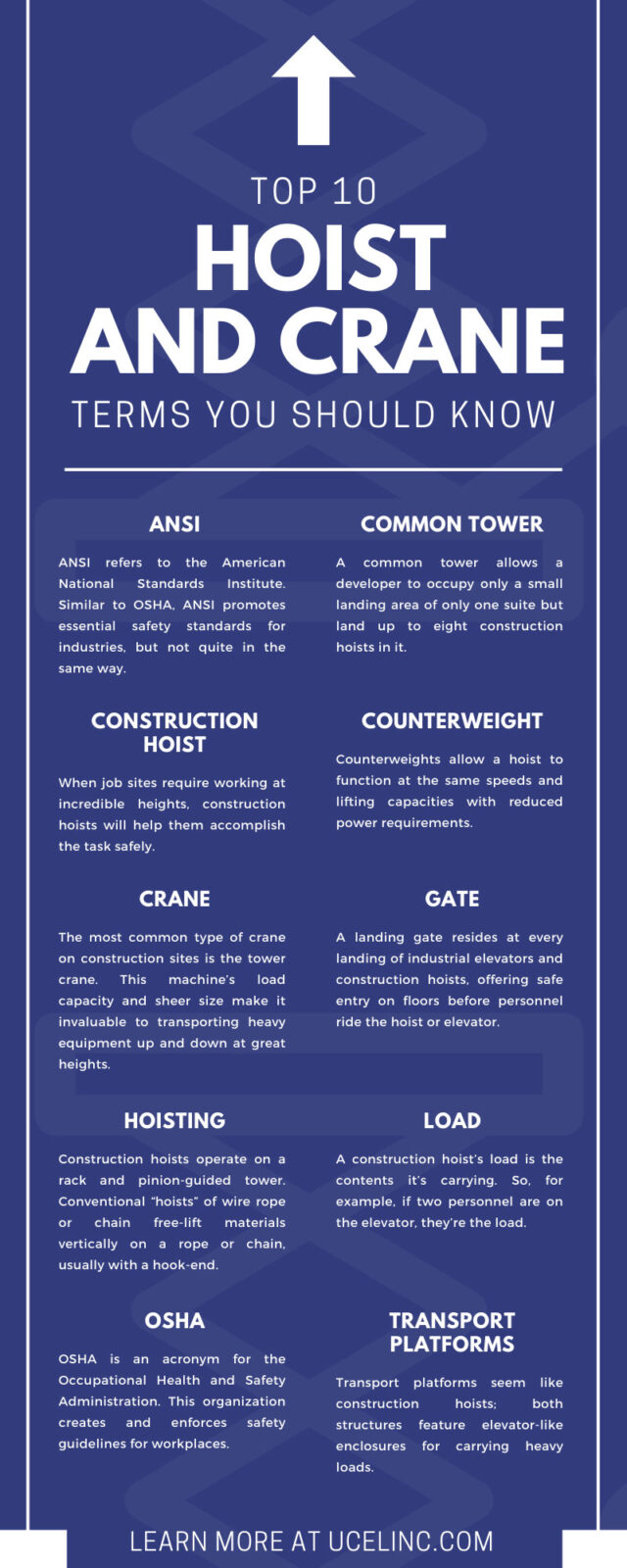Hoists and cranes are commonplace in the construction industry, especially when working with high-rise structures. Although these machines seem straightforward, they involve a lot of complex terms and phrases that can cause some confusion in the workplace.
Thankfully, having a clear definition of the most prevalent industry terms will help you navigate the industry effectively. Communication is key in construction, so use the guide below to understand the top hoist and crane terms you should know.
ANSI
ANSI refers to the American National Standards Institute. Similar to OSHA, ANSI promotes essential safety standards for industries, but not quite in the same way.
ANSI does not create the standards themselves, but they oversee the development of industry standards, ensuring that each is relevant and optimal for the designated workplace. For hoist and crane applications, ANSI is an invaluable resource for helping businesses follow the proper industry practices.
Common Tower
A common tower allows a developer to occupy only a small landing area of only one suite but land up to eight construction hoists in it. This is advantageous because the builder can occupy their units much earlier, which has huge financing implications. Floor access can also be selectively removed from the common tower to allow unit finishing while still servicing higher floors.
Thanks to common towers, multiple hoists can fit in one convenient unit. A quality common tower can advance your build schedule, reduce your cost to float financing, and provide a lot of flexibility and vertical lifting power on site.
Construction Hoist
When job sites require working at incredible heights, construction hoists will help them accomplish the task safely. That said, a construction hoist isn’t your average hoist. Instead of a simple rope system, a construction hoist is a comprehensive, sturdy elevator.
Personnel can ride construction hoists when working on high-rises. In addition, these elevators can carry various job site equipment and lift curtain wall systems, allowing construction crews to successfully use gear on large buildings.
Counterweight
Counterweights allow a hoist to function at the same speeds and lifting capacities with reduced power requirements. This allows motors and drive systems to be smaller, decrease wear and tear, and reduce amperage draws from the power grid.
However, they aren’t always preferred in today’s age of fast-paced building because they add labour time to extensions and installations.
Crane
Similar to construction hoists, industrial cranes move heavy-duty loads on job sites. However, like the term “hoist,” “crane” is also a broad term.
The most common type of crane on construction sites is the tower crane. This machine’s load capacity and sheer size make it invaluable to transporting heavy equipment up and down at great heights. Unlike the elevator-like tower structure of construction hoists, cranes use hooks for carrying loads.
Gate
While “gate” is, of course, a term you’ll frequently hear outside of industrial work environments, gates serve a specific purpose in conjunction with construction hoists.
A landing gate resides at every landing of industrial elevators and construction hoists, offering safe entry on floors before personnel ride the hoist or elevator. This topic might sound straightforward, but landing gates come in many forms.
For example, conventional gates swing open, but some gates can slide horizontally, while others open vertically with the help of counterweights. Either option is suitable, so it all comes down to what’s best for accommodating the specific job site requirements. In addition, side-loading gates can accommodate oversized materials on the job site.
At UCEL, we provide customers with these types of landing gates and more, including bi-parting, vertical bi-parting, vertical counterweighted, horizontal sliding, single-parting, and over-height gates. Now that you know the many types of landing gates available, you can meet job site needs perfectly.
Hoisting
Defining this term is essential because, as mentioned above, the term “hoist” is broader than you might expect. For industrial purposes, hoisting refers to lifting materials.
However, the term “hoisting” can mean different things depending on your application. Whereas we provide construction hoists, the sole word “hoist” frequently refers to rope or pulley systems. Besides their ability to transport things up and down, these two systems are very different from one another. Construction hoists operate on a rack and pinion-guided tower. Conventional “hoists” of wire rope or chain free-lift materials vertically on a rope or chain, usually with a hook-end.
Load
Many construction procedures require calculating loads, whether on a forklift or a construction hoist. That said, “load” is a term that’s applicable to many industries for the same reason.
A construction hoist’s load is the contents it’s carrying. So, for example, if two personnel are on the elevator, they’re the load. Furthermore, knowing this term is critical because of load capacity. A machine’s load capacity refers to its maximum carrying weight; anything above the designated capacity would create a safety hazard. Not all elevating devices come with weight sensors, so it is critical to have a competent operator assess loads put into the machine.
OSHA
OSHA is an acronym for the Occupational Health and Safety Administration. This organization creates and enforces safety guidelines for workplaces. Not only are construction sites a workspace, but they also feature heavy, potentially dangerous materials.
For these reasons, anyone dealing with cranes and construction hoists must know the OSHA guidelines applicable to their work environment. For instance, OSHA standard 1926.552 details safety protocols for working with personnel hoists and other industrial machines.
Following OSHA’s guidelines will help companies avoid dire accidents and hefty fines starting at $10,000. OSHA sets the standards for safety across many industries.
Transport Platforms
This structure is one of the top hoist and crane terms you should know because it presents an alternative material-moving solution. Transport platforms seem like construction hoists; both structures feature elevator-like enclosures for carrying heavy loads.
However, the former consumes less power during routine operations. As a result, transport platforms are a more cost-effective and eco-friendly solution to transporting goods in low-traffic, low-rise worksite conditions.
Using Your Knowledge in the Field
Now that you know these terms, you can avoid making novice mistakes such as buying the wrong type of hoist, crane, or landing gate. Besides purchasing mistakes, communication slip-ups can cause confusion on job sites.
After all, if you refer to a construction hoist as simply a hoist, it’s going to confuse your colleagues. Hoisting operations require a lot of specific terminologies to ensure everything moves safely and efficiently. Furthermore, knowing these terms means you can spot miscommunication between employees easier, correcting improper terminology when it arises.

